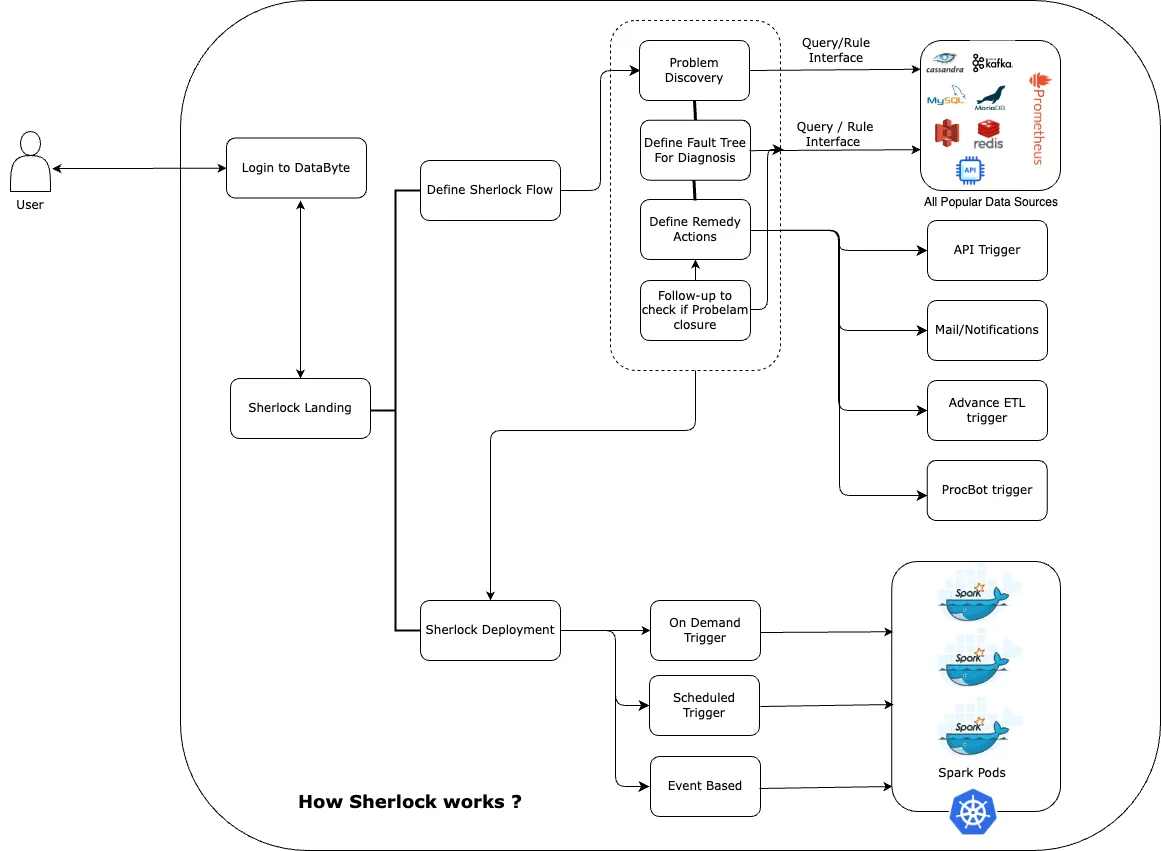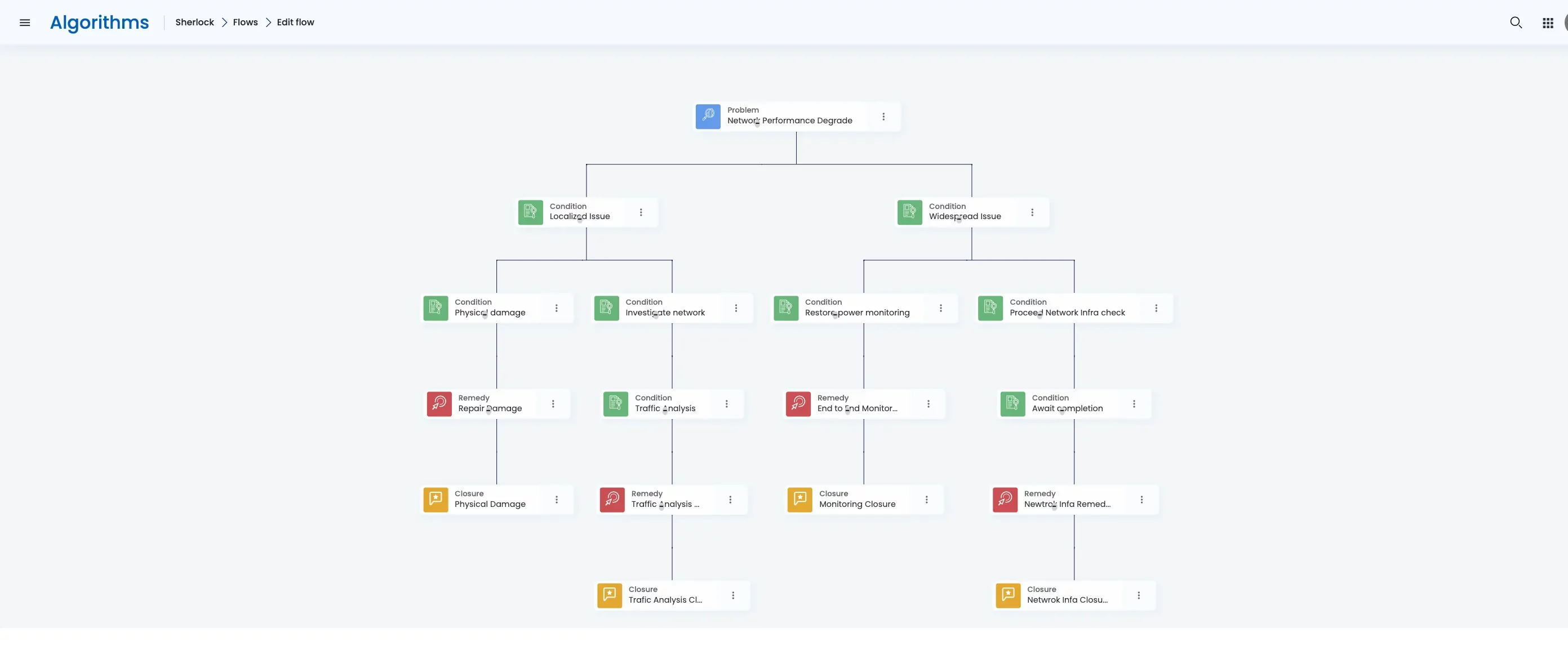
Sherlock: Revolutionizing Enterprise Root Cause Analysis.
In today’s complex and multifaceted enterprise environments, identifying and addressing problems swiftly is crucial. Sherlock, a cutting-edge Root Cause Analysis (RCA) detection tool developed by DataByte, stands out as a revolutionary product in this domain. Sherlock empowers enterprises with an intuitive UI to create Fault Tree Definitions efficiently, allowing users to select data sources and define customized rules. Herein, we will delve deep into what makes Sherlock a pivotal tool in enterprise problem detection and resolution.
It is an enterprise-focused Root Cause Analysis (RCA) detection tool designed to automate the process of identifying the core problems within a system. It surpasses other RCA tools by providing a seamless and user-friendly interface, enabling businesses to create Fault Tree Definitions with ease and precision.
Challenges Enterprises Face
- Voluminous Data Streams: With an overwhelming amount of data, pinpointing slight deviations becomes like searching for a needle in a haystack.
- Interpreting Anomalies: Detecting an anomaly is one thing; understanding its significance and root cause is another challenge altogether.
- Scalability and Speed: With expanding data sources and increasing data velocities, traditional tools often fail to provide timely and scalable solutions.
- Silos of Operations: Different departments use different tools, leading to a lack of unified vision and collaboration in diagnosing and rectifying issues.
- Lack of Proactive Remedies: Traditional RCA tools often stop at just identifying the root cause, without providing immediate actionable remedies.
How Sherlock Works?

Core Features?
- Intuitive Design Interface: Sherlock offers a user-friendly and intuitive design interface that allows users to effortlessly craft the fault tree. This interface is pivotal in aiding users in visualizing and organizing their fault analysis in a tree view.
- Rule definitions: The advanced rule definition feature in Sherlock includes an interactive and user-friendly UI. This UI is instrumental in defining clear and concise rules swiftly and effectively. The rules set the boundaries and parameters for fault detection and resolution.
- Unified query interface: Sherlock’s unified query interface streamlines the data retrieval process by offering a one-stop solution for writing queries. This feature ensures that users can fetch the necessary data with minimal hassle, optimizing the time spent on data collection and enabling a more focussed approach to problem-solving and analysis.
- Kubernetes Integration: Integrated seamlessly with Kubernetes, Sherlock ensures the robust management and deployment of applications within containers. It allows enterprise to adopt the Sherlock quickly, regardless of the scale and complexity of the operational environment.
- Apache Spark based execution with Kubernetes: The implementation of Apache Spark in Sherlock’s execution processes guarantees fast, in-memory computation and exceptionally efficient data processing. The spark-based execution is essential for handling large datasets and performing complex computations.
- Remedy action definition: Sherlock provides a versatile remedy action definition interface that allows users to define varied actions such as triggering an API or Data API(https://medium.com/@databyte_tech/database-api-unified-database-query-interface-using-rest-apis-2a57192ba2cf) , sending notifications, initiating advanced ETL flows, or ProcBot (https://medium.com/@databyte_tech/procbot-scalable-automation-for-your-business-b7e219824be1) triggers. This versatility is integral in addressing different operational needs and ensuring that the appropriate corrective actions are taken promptly.
- Detailed execution analysis: Featuring a unified and comprehensive dashboard, Sherlock offers detailed execution analysis, enabling users to delve deep into every aspect of the execution process. This feature is invaluable for gaining insights, monitoring processes effectively, and understanding the intricate details of executions.
Each of these features ensures that Sherlock delivers an enriched experience, providing users with maximum operational efficiency, profound insights, and a plethora of action triggers to accommodate a variety of needs, all with minimal hassle and optimal performance.
Use cases:
The RCA process is crucial for any enterprise businesses, There are many use cases and scenario where enterprise operations needs to collect the Root cause for occurred problem.
Let’s take an example:
Automated RCA detection on Performance degradation of an IOT device:
Scenario:
An enterprise has a complex IT network system with various interconnected components and services. Frequent performance degradation in the network affect the enterprise’s daily operations. Sherlock is implemented to perform automated Root Cause Analysis (RCA) and resolve the issues swiftly with Remedy actions.
The simple RCA tree will look like below which is designed in Sherlock

Deployment and Execution:
Deployment Type:
- Scheduled Batch deployment, with frequent intervals to monitor the network system consistently.
- On-demand trigger
- Event-based trigger
Execution Platform:
- Sherlock triggers the fault tree based on the schedule on its Kubernetes-integrated environment using scalable Spark processes.
Result:
- The enterprise experiences a reduction in network-related disruptions and quicker resolutions, minimizing downtime and improving overall operational efficiency.
Benefits to Enterprise:
- Enhanced Operational Efficiency: Quick identification and resolution of network faults ensure smooth operations and reduce downtime.
- Proactive Monitoring: Regular scheduled deployments of Sherlock allow early detection of potential issues, enabling proactive resolutions.
- Insightful Analysis: Detailed execution analysis offers insights into recurring issues and helps in optimizing network performance.
Conclusions:
In the vast universe of enterprise data, things can sometimes go awry. Imagine navigating a bustling metropolis without a map or traffic signals. Businesses, big or small, often face the challenge of swiftly spotting these data “traffic jams” (anomalies) and understanding their root causes. Addressing these issues quickly and efficiently can make the difference between smooth operations and significant business disruptions.
Credit: Featured Image by wayhomestudio on Freepik



